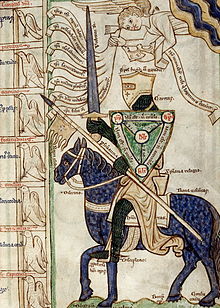Miles Christianus
This articleneeds additional citations forverification.(May 2013) |


Themiles Christianus(Christiansoldier) ormiles Christi(soldier ofChrist) is a Christianallegorybased onNew Testament military metaphors,especially theArmor of Godmetaphor of military equipment standing for Christian virtues[1]and on certain passages of theOld Testamentfrom theLatin Vulgate.[2]The plural ofLatinmiles(soldier) ismilitesor the collectivemilitia.[3]
By the 5th century, the Church had started to develop doctrines that allowed for Christian participation in battle, though this was limited by a requirement that the fighting must be undertaken to convertinfidelsor spread theglory of Christ.Christians were not to fight for conquest or personal glory.[4]
Overview
[edit]The concepts ofmiles Christiandmilitia Christican be traced back to the first century AD.[4]The phrasemiles Christi,derived from a letter fromPaul the Apostleand much employed byPope Gregory VII,also appeared in theGesta Francorumin reference to the youngPrince Tancred,Bohemond,GodfreyandCount Raymond of Toulouse,[5]each of whom were Christian leaders in theFirst Crusade.
The metaphor has its origins in early Christianity of the Roman Empire, and gave rise to the contrasting termpaganus(hitherto used in the sense of "civilian," "one lacking discipline" ) for its opposite, i.e. one who was not a soldier of Christ.[6]
Chivalryas the idealized image ofknighthoodwas a commonmoral allegoryin early Christian literature.[4]During theSaxon Wars,Charlemagne's Christian knights attended Mass, surrounded by relics, before battles.[4]
Fragments from 15th c. Polish chroniclerJan Długoszdescribe thesanctificationof weapons and a concept of knighthood that was grounded in religion.[4]It became a theme inartduring theHigh Middle Ages,with depictions of aknightwith his various pieces of equipment identified with variousvirtues.This parallels the development of the understanding in medievalChristendomof the armed nobility as defenders of the faith, first emphasized byGregory VIIin the context of theInvestiture controversyand later made even more explicit with the actual military expeditions of thecrusades. Depictions of themiles christianuswith the emblematic Armour of God however remained very rare in the medieval period and only became prominent after theProtestant Reformation.[7]
In theearly modern period,the understanding of the term again became more metaphorical, but it survives in various Christian orders or confessions; it is especially pronounced among theJesuitsand in theSalvation Army,and it is the central theme of the 18th century hymn "Soldiers of Christ, Arise"and the 19th century hymn"Onward, Christian Soldiers."
There is a Korean-American religious group called the Soldiers of Christ, which became the center of a 2023 murder case.[8]
See also
[edit]- Athleta Christi
- Militia Dei
- Military order (society)
- Military saint
- Mujahideen
- Regimini militantis Ecclesiae
- Spiritual warfare (Christianity)
References
[edit]- ^Ephesians 6:14–17
- ^Job 7:1(Vulgate):Militia est vita hominis super terram...
- ^Brian A. Catlos, "Militia Christi",Oxford Dictionary of the Middle Ages(Oxford, 2010), definesmilitia Christias the "idea of service to the church, with military connotations derived from crusading ideology andBernard of Clairvaux's writings. "
- ^abcdeIwanczak, Wojciech (2012)."Miles Christi: the medieval ideal of knighthood".Journal of the Australian Early Medieval Association.8(Journal Article): 77–.ISSN1449-9320.
- ^Kostick, Conor (2008).The Social Structure of the First Crusade.Leiden, Netherlands: Koninklijnke Brill NV. p. 20.ISBN978-9004166653.
- ^Ernest Weekley,Etymological Dictionary of English,s.v. "pagan".
- ^"depictions of the miles christianus in emblematic armour are extremely rare before the Reformation" (Evans p. 14)
- ^"6 'Soldiers of Christ' arrested for the abuse and murder of 'malnourished' South Korean woman".CNN.15 September 2023.
- Michael Evans, "An Illustrated Fragment of Peraldus'sSummaof Vice: Harleian MS 3244 ",Journal of the Warburg and Courtauld Institutes,vol. 45 (1982), pp. 14–68.
